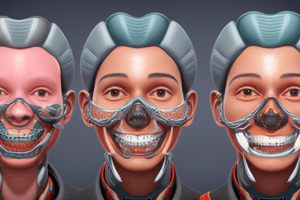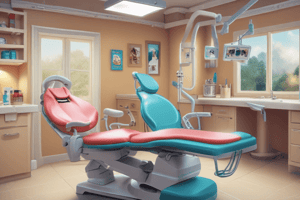Podcast
Questions and Answers
Ethyl alcohol causes a deficiency in the ______ of the face
Ethyl alcohol causes a deficiency in the ______ of the face
central mid-face
Vitamin D excess can lead to ______ and premature suture loss
Vitamin D excess can lead to ______ and premature suture loss
craniosynostosis
The Rubella virus can cause ______, cataracts, and deafness
The Rubella virus can cause ______, cataracts, and deafness
microphthalmia
X-radiation can cause ______ in the fetus
X-radiation can cause ______ in the fetus
Pierre Robin syndrome is characterized by a ______ mandible
Pierre Robin syndrome is characterized by a ______ mandible
Treacher Collins syndrome is also known as ______ syndrome
Treacher Collins syndrome is also known as ______ syndrome
Malocclusion can be caused by ______ factors such as birth injury or delivery-induced deformation
Malocclusion can be caused by ______ factors such as birth injury or delivery-induced deformation
Prolonged retention of deciduous teeth can lead to ______ eruption of permanent teeth
Prolonged retention of deciduous teeth can lead to ______ eruption of permanent teeth
The duration of a force is more important than its ______ in terms of its biological response
The duration of a force is more important than its ______ in terms of its biological response
Forces applied during chewing, pressure from lips, cheeks, and tongue, and pressures from external sources are all part of the ______ that affects the dentition
Forces applied during chewing, pressure from lips, cheeks, and tongue, and pressures from external sources are all part of the ______ that affects the dentition
Flashcards are hidden until you start studying
Study Notes
Congenital Anomalies
- Hutchinson's incisors and mulberry molars are aberrations associated with congenital syphilitic pulp chamber.
- Peg-shaped laterals are a type of congenital anomaly.
- Torticollis (Wryneck) can cause profound changes in the bony morphology of the cranium and face.
- Amelogenesis imperfecta and hypoplasia are congenital defects.
- Cleidocranial dysostosis is characterized by unilateral or bilateral, partial or complete absence of the clavicle (collar bones).
Etiology of Malocclusion
- Congenital syphilis can cause abnormally shaped teeth and malposed teeth.
- Cleft lip and palate can lead to missing teeth (congenital absence or loss due to accidents, caries).
- The order of frequency of absence is: maxillary & mandibular third molars, maxillary lateral incisors, mandibular second premolar, mandibular incisors, and maxillary second premolars.
- More teeth are absent on the left than right side, especially in permanent teeth.
- Ectodermal dysplasia-anodontia or oligodontia is characterized by the absence of all or most of the permanent teeth, associated with an unusual but mild systemic abnormality, thin and sparse hair, and an absence of sweat glands.
Anomalies of Tooth Size and Shape
- Tooth size is largely determined by heredity.
- Width increments are greater in males than females, more pronounced in permanent teeth.
- Anomalies of tooth shape include peg laterals, mandibular second premolar with an extra lingual cusp, and dens in dente.
Developmental Defects
- Amelogenesis imperfecta, hypoplasia, gemination, dens in dente, odontomas, and fusion (teeth with separate pulp chambers joined at the dentin) are developmental defects.
Other Conditions
- Cerebral palsy is a paralysis or lack of muscular coordination attributed to an intracranial lesion.
- Pierre Robin syndrome is characterized by a micro mandible.
- Treacher Collins syndrome/Crouzon's syndrome is characterized by mandibular dysostosis.
Postnatal Factors
- Developmental, functional, and environmental interferences can affect dental development.
- Birth injury, delivery-induced deformation of the upper jaw, disabling accidents, extensive scar tissue, burn, cerebral palsy, and TMJ injury can cause internal injury, loss of tissue, and underdevelopment of the mandible.
Equilibrium
- Forces applied during chewing, pressure from lips, cheeks, and tongue, and pressures from external sources (habits & orthodontic appliances) affect the dentition.
- The duration of a force is more important than its magnitude due to the biological response.
Studying That Suits You
Use AI to generate personalized quizzes and flashcards to suit your learning preferences.




